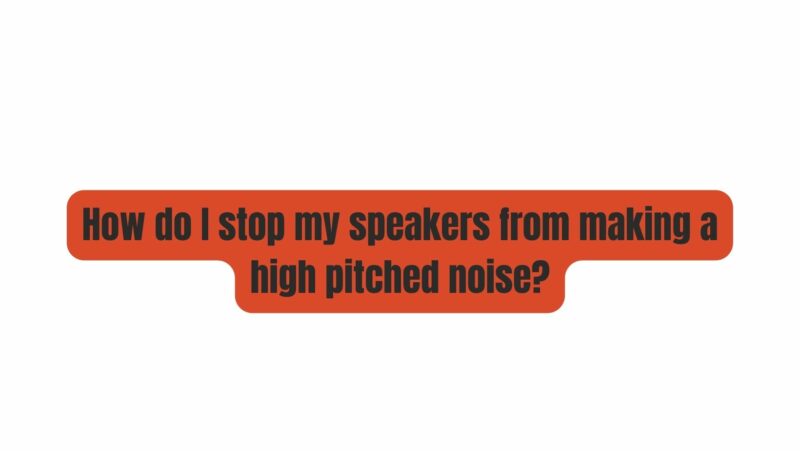Speakers are the gateway to auditory bliss, faithfully reproducing music, dialogue, and soundscapes. Yet, within the realm of sonic euphoria, an unwelcome intruder sometimes lurks – a high-pitched noise. This piercing sound can be both infuriating and perplexing. In this article, we embark on a journey to understand the causes of high-pitched noises in speakers and explore practical strategies to prevent and mitigate them. By mastering the art of silencing the squeal, you can ensure your audio experience remains uninterrupted and enjoyable.
Understanding the Basics: How Speakers Work:
Before we dive into the methods to prevent high-pitched noises in speakers, let’s establish a foundational understanding of how these audio devices operate:
- Sound Reproduction: Speakers transform electrical audio signals into audible sound waves. They achieve this by rapidly vibrating a diaphragm (typically a cone or dome), generating fluctuations in air pressure that produce sound.
- Components of a Speaker: A typical speaker comprises a diaphragm, a voice coil, a magnet, and a frame. These components collaborate to produce sound as the voice coil moves within the magnetic field, vibrating the diaphragm.
- Signal Transmission: An audio signal, generated by an amplifier or audio source, is conveyed to the speaker. This signal causes the voice coil to move, inducing vibrations in the diaphragm and generating sound.
The Perplexing High-Pitched Noise: Common Causes:
High-pitched noises in speakers can disrupt your auditory pleasure. Let’s explore some common sources of these unwelcome sounds:
- Feedback and Microphones: In live sound setups or recording environments, high-pitched noises can occur when microphones pick up the sound produced by the speakers and feed it back into the audio system. This creates a loop of amplified sound, often manifesting as a squeal or screech.
- Resonance and Cabinet Vibration: Some speakers, particularly those with less rigid cabinets or enclosures, can resonate at specific frequencies, resulting in high-pitched noises. This can be caused by loose components, poor cabinet construction, or improper placement.
- Port Noise: Speakers with ports (also known as bass reflex ports) can produce high-pitched noises if air turbulence occurs within the port. This turbulence creates a distinct squealing or chuffing sound.
- Electromagnetic Interference (EMI): Electromagnetic interference from nearby electronic devices or unshielded cables can introduce noise into the audio signal, leading to high-pitched sounds in the speakers.
Preventing High-Pitched Noise: Strategies and Best Practices:
Now that we’ve identified the potential sources of high-pitched noises, let’s delve into strategies and best practices to prevent and mitigate them:
- Microphone Management: In live sound setups or recording sessions, manage microphones carefully to prevent feedback-induced high-pitched noise. Adjust microphone placement and angles to minimize the risk of feedback. Employ feedback eliminators or digital feedback suppression tools as needed.
- Speaker Cabinet Damping: Enhance the rigidity and damping of your speaker cabinet or enclosure. You can achieve this by adding internal bracing, acoustic foam, or damping materials to reduce resonance. Ensure that all components are securely fastened within the cabinet.
- Port Optimization: If your speakers have ports, optimize their design to minimize port noise. Experiment with different port lengths and shapes, and consider using foam plugs or external port tubes to control air turbulence and prevent high-pitched noises.
- EMI Mitigation: Isolate your speaker setup from potential sources of electromagnetic interference. Use shielded audio cables to minimize EMI pickup. Position electronic devices away from the speakers, and consider using power conditioners or surge protectors with EMI filtering to provide clean power to your audio equipment.
- Proper Grounding: Ensure that your audio system, including amplifiers and signal processors, is properly grounded. Proper grounding helps reduce the risk of ground loops, which can introduce unwanted noise into the audio signal path.
- Feedback Prevention: Implement sound reinforcement and monitoring practices that minimize the risk of feedback. Use stage monitors effectively to provide performers with clear audio without the need for excessive stage volume, which can lead to feedback issues.
- Regular Maintenance: Periodically inspect your speakers and audio equipment for loose connections, damaged components, or signs of wear. Address any issues promptly to prevent high-pitched noises from developing.
Conclusion: A Quieter Audio Journey:
High-pitched noises in speakers may temporarily disrupt your auditory experience, but with an understanding of their causes and the application of preventive measures, you can enjoy uninterrupted and pleasing sound quality. Whether it’s preventing feedback, optimizing cabinet damping, or eliminating port noise, the key lies in proactive management and a commitment to maintaining your audio equipment. Embrace the challenge of silencing the squeal, and let your speakers continue to be the conduits for the captivating melodies and immersive soundscapes that enrich your life.

